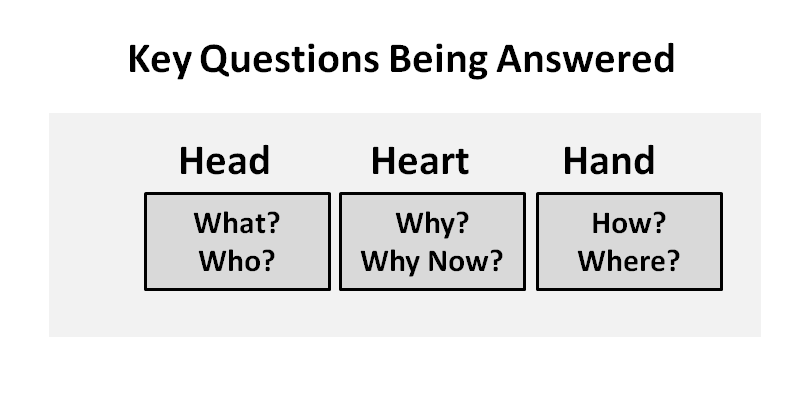After reading Switch (affiliate link) by the Heath brothers, I am convinced that successful consulting projects must appeal to the head, the heart and the hand. It is a simple way to think about change and also makes a lot of sense.
- Head: The logic of the analysis and recommendation
- Heart: Why the client should change
- Hand: Making it easy to implement the change daily
It answers the key questions that people have. Who, What, Why, When, Where, How. The narrative goes: Yes, we need a strategy and plan (head), leadership and a call-to-action (from the heart), and some detailed steps (for the hand).


It’s a trifecta, but all too often executives (and consultants) only get 1 or 2 of them right. This can cause problems as described below:
#1: Head, but no Heart or Hand.
This is quite common. The consultants do a great job of solving the problem on paper, but don’t give enough consideration on how the client will motivate (heart) her people to take action, or specifically what the direct reports (hands) need to be doing. Lots of high-power thinking, but that is about it. The solution is too theoretical, complex, or radical. I have heard executives joke that consulting recommendations that were “shelf-ware” because it was so impractical that it went right on the shelf, as if it was a textbook.
Sometimes a client will call you for something very tactical – perhaps writing a Standard Operating Procedure (SOP), or creating some training materials – that can be handled quickly and cheaply. Unsurprisingly, the results are also limited and muted.
#3 Heart, but No Head, No Hand
Executives (CEO, COO, CEO etc) sometimes develop pet projects, especially ones that are related to leaving a legacy, that don’t always pass muster. This is probably one of the main reasons that 2/3 of mergers tend to fail (the destroy economic value). Either the deal does not make economic sense (e.g., Zynga buying Draw Something maker OMGPOP for $180 million) or there is poor implementation (e.g., see McKinsey’s report on Where Mergers go Wrong)
I think you get the idea. You need all three elements for change to really take root. If you only have 2 of the 3, you might reach the goal-line, but it will be slower and more painful that you anticipated. Can you imagine:
- Scenario #4: Reckless enthusiasm because there is a lot of vision, passion, activity, but not much of a plan.
- Scenario #5: Strategy without legs because there is a reasonably well thought-out plan and vision, but nothing is happening. The troops don’t know what to do.
- Scenario #6: Disjointed action because there is a strategic plan and roadmap. We all know what needs to be done, but frankly, none of us know why we are doing it – other than our bosses told us to do it.
Good management consultants know how to piece together the head, heart and the hand. It can be complicated and often takes time because culture does not change over-night. We also need to remember that most people in the organization know very little about our projects. They will be the last to hear about it, and it is usually only by email or some other generic announcement. Complex problems require thinking, feeling and doing.
“For every complex problem there is an answer that is clear, simple, and wrong.” – H.L. Menken
